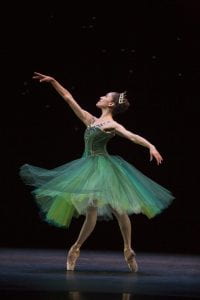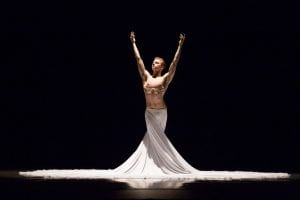Pacific Northwest Ballet’s Fall dance programs were both digital triumph and critical success. Kudos to artistic director Peter Boal and his administrative and artistic staff for presenting such stunning and sensitive dance to the world.
Reviews, in brief

Rep I (streamed in October). PNB’s Rep I featured George Balanchine’s Jewels, but all the pieces on the program were gems. Adding to the luster was the expert videography, giving viewers the chance to see these highly skilled artists up close, with relaxed faces and gestures, and otherwise virtuosic moves prominently displayed, as in Lucien Postlewaite’s gorgeous solo from Jerome Robbins’ Dances at a Gathering. Several sections from Eva Stone’s Foil were performed. In “Be Still,” Amanda Morgan, Cecilia Iliesiu, and Juliet Prine created a stunning visual—with their bare backs to the audience and wearing billowing skirts, and all delivering striking synchronous upper body and arm movements. In Kent Stowell’s Swan Lake, of particular note was the daring Kyle Davis in the pas de trois variation and the extraordinarily articulate Elizabeth Murphy in the Odette variation. Angelica Generosa and Steven Loch gave a star turn in the Black Swan pas de deux. Both are amazingly steady dancers—precise and confident. Although it’s easy to obsess on the outstanding technique (those fouetté turns, Loch hovering in his jumps, for example), a main attraction was the distinct chemistry between the two.
Impressive, too, was Sarah-Gabrielle Ryan and Kyle Davis in their radiant pas de deux in Balanchine’s Rubies. Both danced with aplomb, dancing “big” as much as possible with all the quick steps the piece demands. Leta Biasucci is in supreme control of any material she dances, but her pacing and musicality in Emeralds was exceptionally flawless. Lesley Rausch and Jerome Tisserand were similarly brilliant in their joyful, technical scherzo in Diamonds.
Jessica Lang’s The Calling changes dramatically with each dancer’s interpretation. Dylan Wald’s was intensely beautiful, in his delivery of the many shapes and images—and the smooth transitions among them. Marco Goecke’s Mopey is a stamina-demanding solo that James Moore has mastered over the years. Each time he performs it, we see fresh, poignant sides of the dance and dancer. Christopher D’Ariano’s performance in Albert Evans’ One Body required resilience and resolve, as well as technique to showcase his exact landings and expansive aerial work. Ulysses Dove’s Red Angels is a study in articulation of body joints. Of note was William Lin-Yee’s swag-like flexibility, Postlewaite’s quick, expressive moves, Iliesiu’s open and passionate dancing, Morgan’s clear and assured undulations. The ensemble accomplished much movement in a small space, transforming the dance from mere steps into an entirely compelling experience—aided by the incomparable Michael Jinsoo Lim on violin.


PNB’s annual First Look Gala (streamed in November). The fall PNB gala was billed as a “Look Forward,” and was hosted by the captivating Lucien Postlewaite and Angelica Generosa (who was recently promoted).
In Jessica Lang’s final movement of Ghost Variations (also featured in Rep II), Elle Macy and Dylan Wald danced a luscious pas de deux, wholly in sync with each other in the piece’s classical and contemporary moves. Alejandro Cerrudo’s “PACOPEPEPLUTO” featured three solos danced by Christopher D’Ariano, James Moore, and Lucien Postlewaite—all resplendently grounded. The moves showed off the capabilities of the strong, sinewy men, with Postlewaite deftly dancing one of the more sprightlier, heartening solos. Angelica Generosa’s debut as Odile in the exquisite variation from Swan Lake’s Black Swan pas de deux was stunning. She was coached by the choreographer, Kent Stowell, and Francia Russell. One of the showstoppers of the gala, she was in absolute control throughout the performance. Kudos to Miles Pertl and Leah Terada in their sensitive interpretation of Susan Marshall’s Arms (danced also in PNB’s Rep II), which offered inventive upper body gestures of the arms and torso, danced at “arms’ length.” In Balanchine’s Apollo, the spectacular Lesley Rausch danced as muse to Dylan Wald’s remarkable Apollo, well illustrating the choreographer’s “ballet is woman” theme. Rausch and Wald were elegant, dazzling together, every movement execution choice, picture-perfect. Proceeds from the gala supported PNB’s Future Fund.
Rep II (streamed in November). Rep II featured all-female choreographers, some of whom created world premieres especially for this digital program. A highlight of Penny Saunders’ Wonderland premiere was the unique staging using the entire theater (orchestra pit, audience seats, aisles, the floor), as well as the dance itself. The movements, in solos and groupings, suggested self-reflection and introspection. The piece required emotional interpretations, and stand-outs were Lucien Postlewaite, Elizabeth Murphy, Angelica Generosa, Elle Macy, and Dylan Wald. Also of note were the pieces excerpted from Twyla Tharp’s Waterbaby Bagatelles. Shout out to the entire ensemble, but especially Joshua Grant, Kyle Davis, Jerome Tisserand, and Steven Loch for their superb execution of Tharp’s fast-paced work. Included in the program (and reviewed elsewhere in this post) was Susan Marshall’s Arms premiere and Jessica Lang’s Ghost Variations.